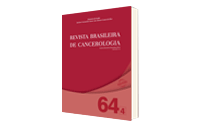Profile of Patients with Esophageal Cancer Diagnosed Between 2001 and 2010 in Brazil
DOI:
https://doi.org/10.32635/2176-9745.RBC.2018v64n4.195Keywords:
Esophageal Neoplasms, Risk Factors, Neoplasm Staging, Brazil, Electronic Health RecordsAbstract
Introduction: Esophageal cancer is the third most common neoplasm of the digestive tract and presents poor prognosis when diagnosed in advanced stages of the disease. Objective: To describe the socio-demographic, clinical and treatment characteristics of patients diagnosed with esophageal cancer in Brazil, from 2001 to 2010. Method: A cross-sectional study of patients with esophageal cancer registered between 2001 and 2010 in Hospital-based registries. Socio-demographic, clinical and treatment variables were analyzed. Descriptive analysis was performed using mean and standard deviation for continuous variables, and absolute and relative frequency for categorical variables. Results: A total of 24,204 patients were included, with a mean age of 60.8 years (± 11.5). The majority of the population was male (78.3%), with a low level of schooling (75.2%), alcoholics (62.9%), smokers (76.0%), and had an advanced stage of diagnosis (41.3% in clinical stage III and 26.9% in stage IV), the topographic group being the most prevalent was in the esophagus upper and middle (76.4%). 12.7% of the patients were not submitted to any cancer treatment. The most frequent treatments were the combination of radiotherapy and chemotherapy (25.6%), and treatment alone with radiotherapy (21.9%). At the end of the first cancer treatment, 10.7% had no evidence of disease, 8.4% had partial remission, 26.6% had a stable disease, and the remaining patients had progression or death (54.4%). Conclusion: In Brazil, the cases diagnosed for esophageal cancer are mostly diagnosed in advanced stages of the disease, which represents greater therapeutic aggressiveness and worse response to treatment.Downloads
Download data is not yet available.
Downloads
Published
2018-12-31
How to Cite
1.
Cruz AIBM, Pinto LFR, Thuler LCS, Bergmann A. Profile of Patients with Esophageal Cancer Diagnosed Between 2001 and 2010 in Brazil. Rev. Bras. Cancerol. [Internet]. 2018 Dec. 31 [cited 2025 Dec. 13];64(4):471-7. Available from: https://rbc.inca.gov.br/index.php/revista/article/view/195
Issue
Section
ORIGINAL ARTICLE









